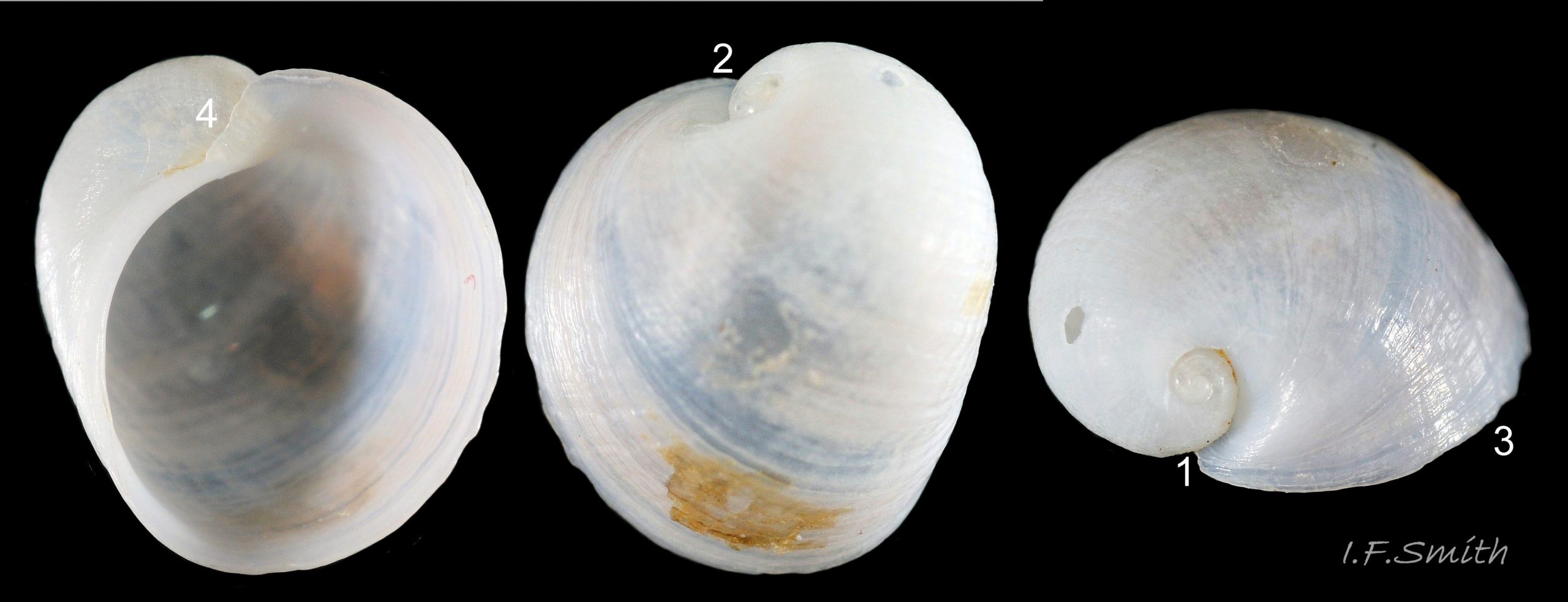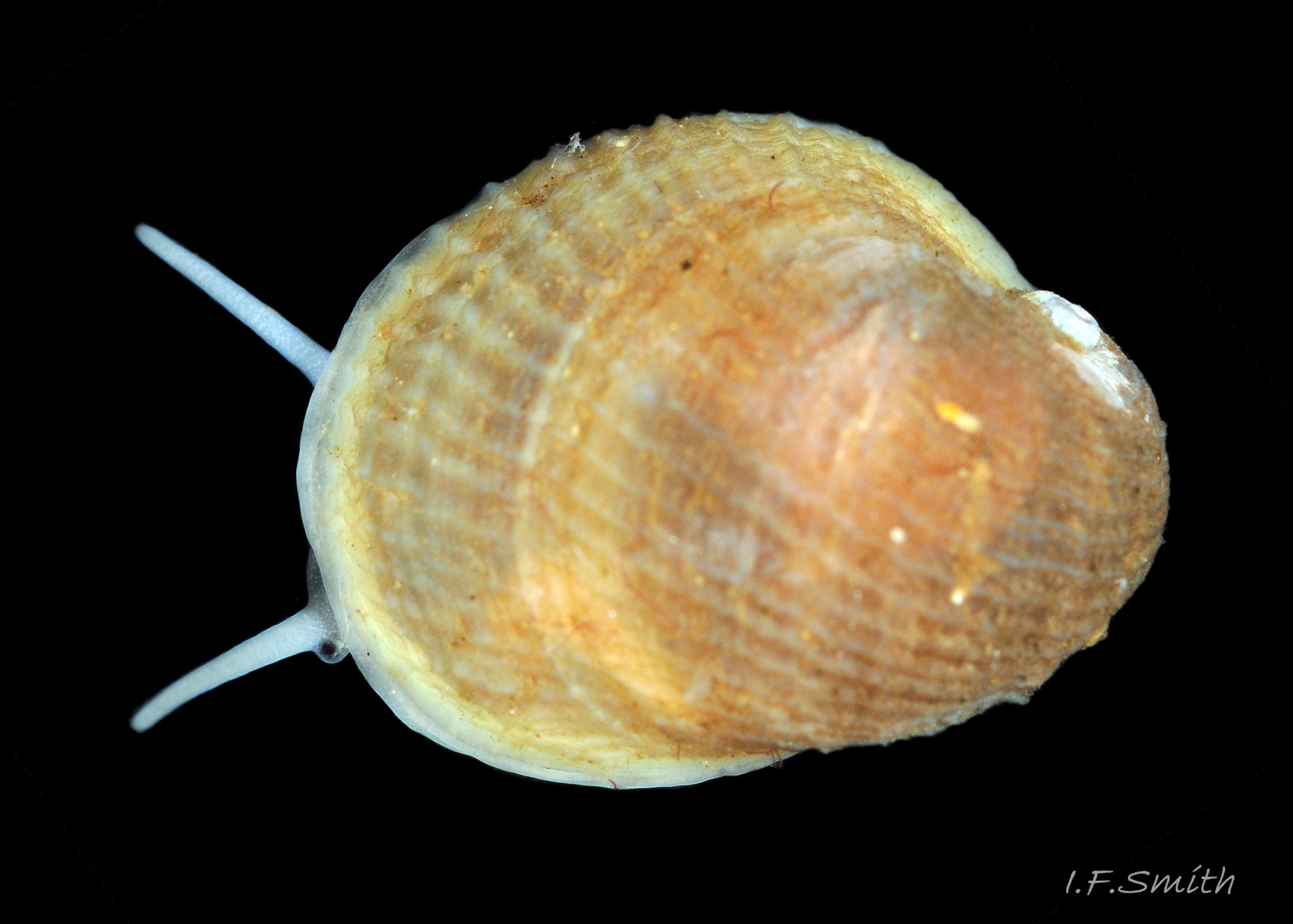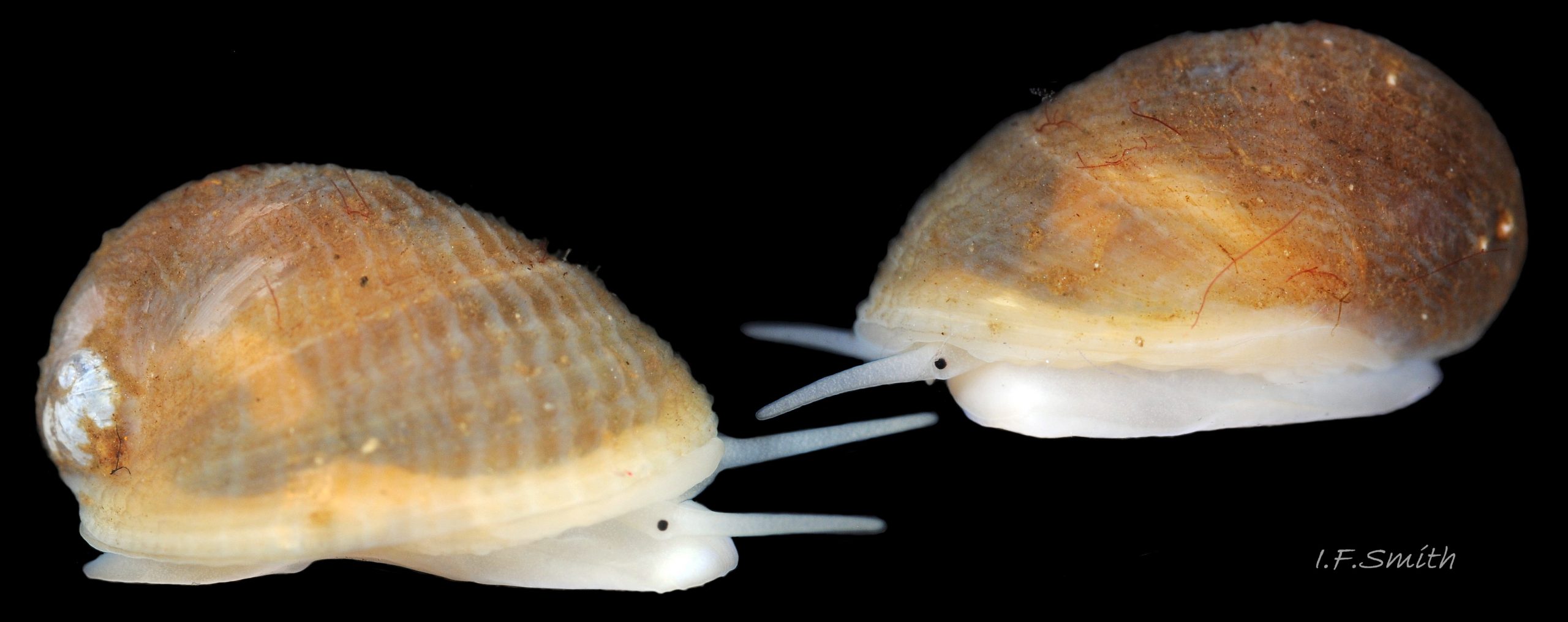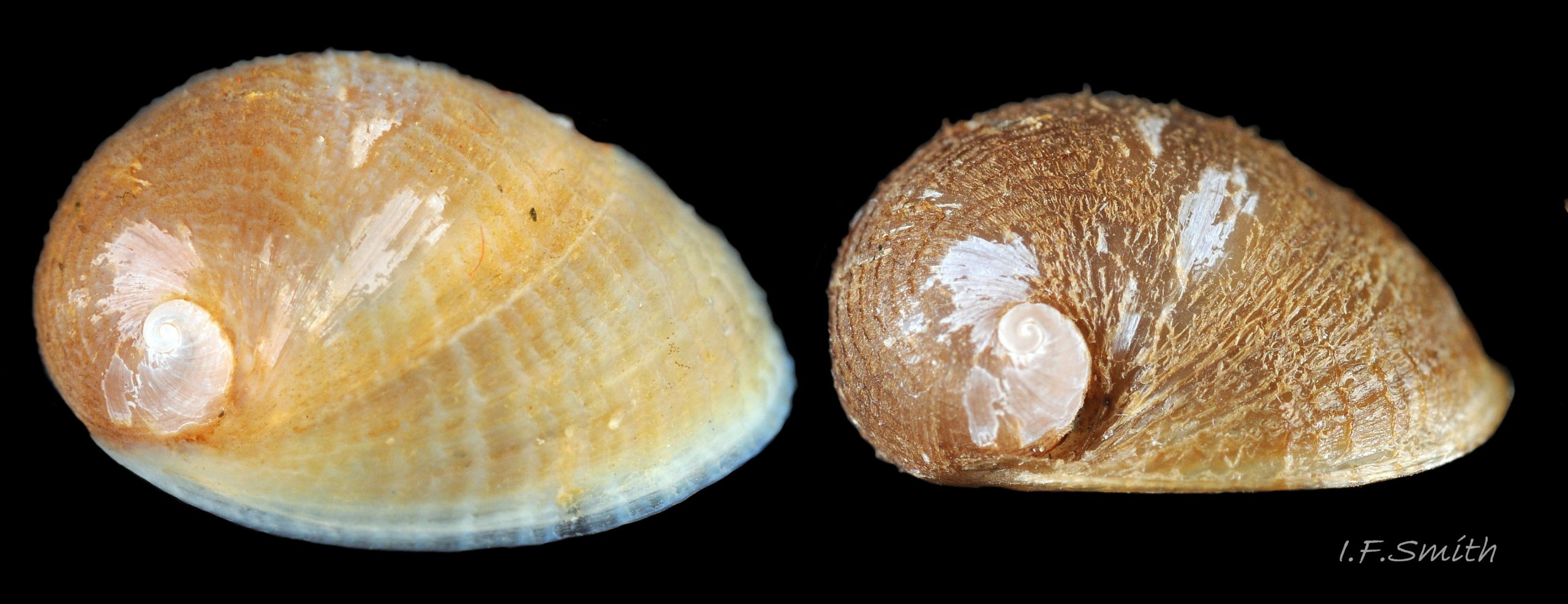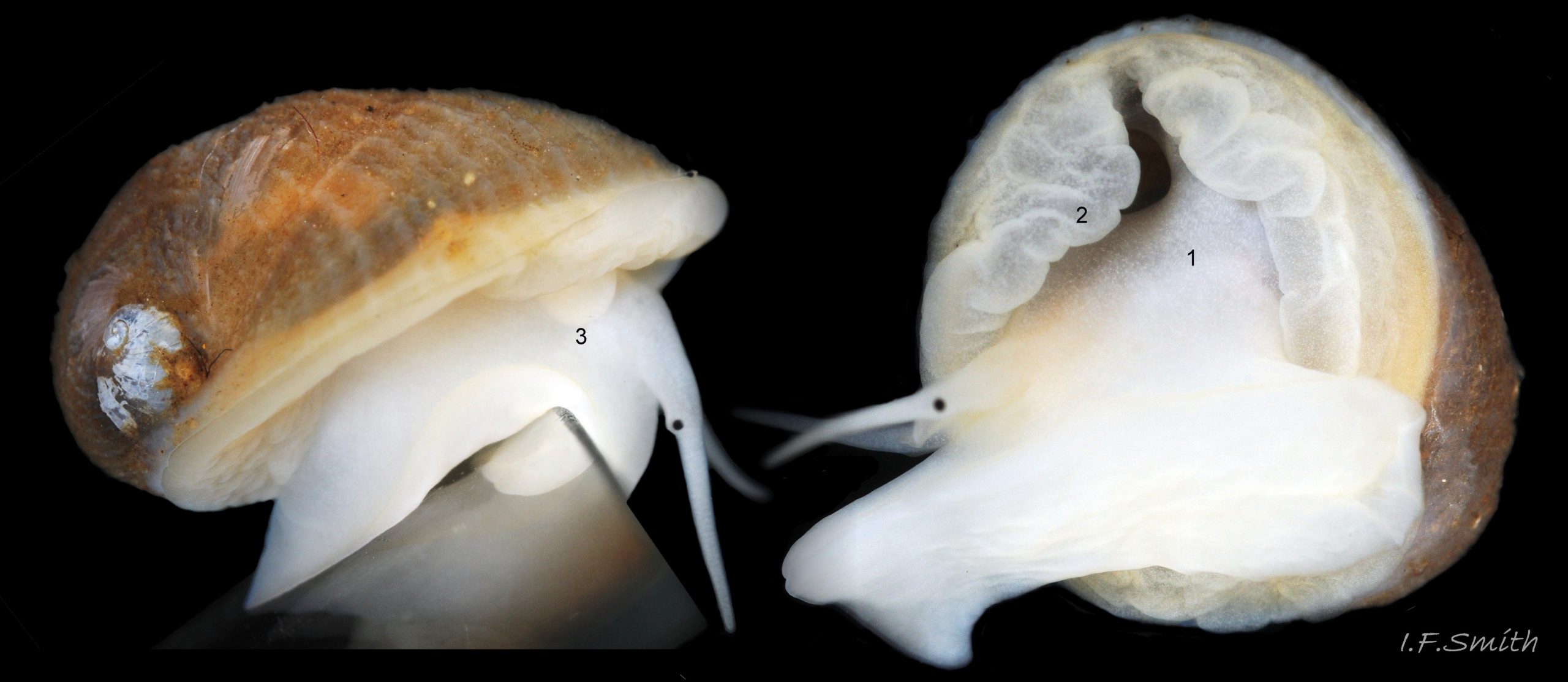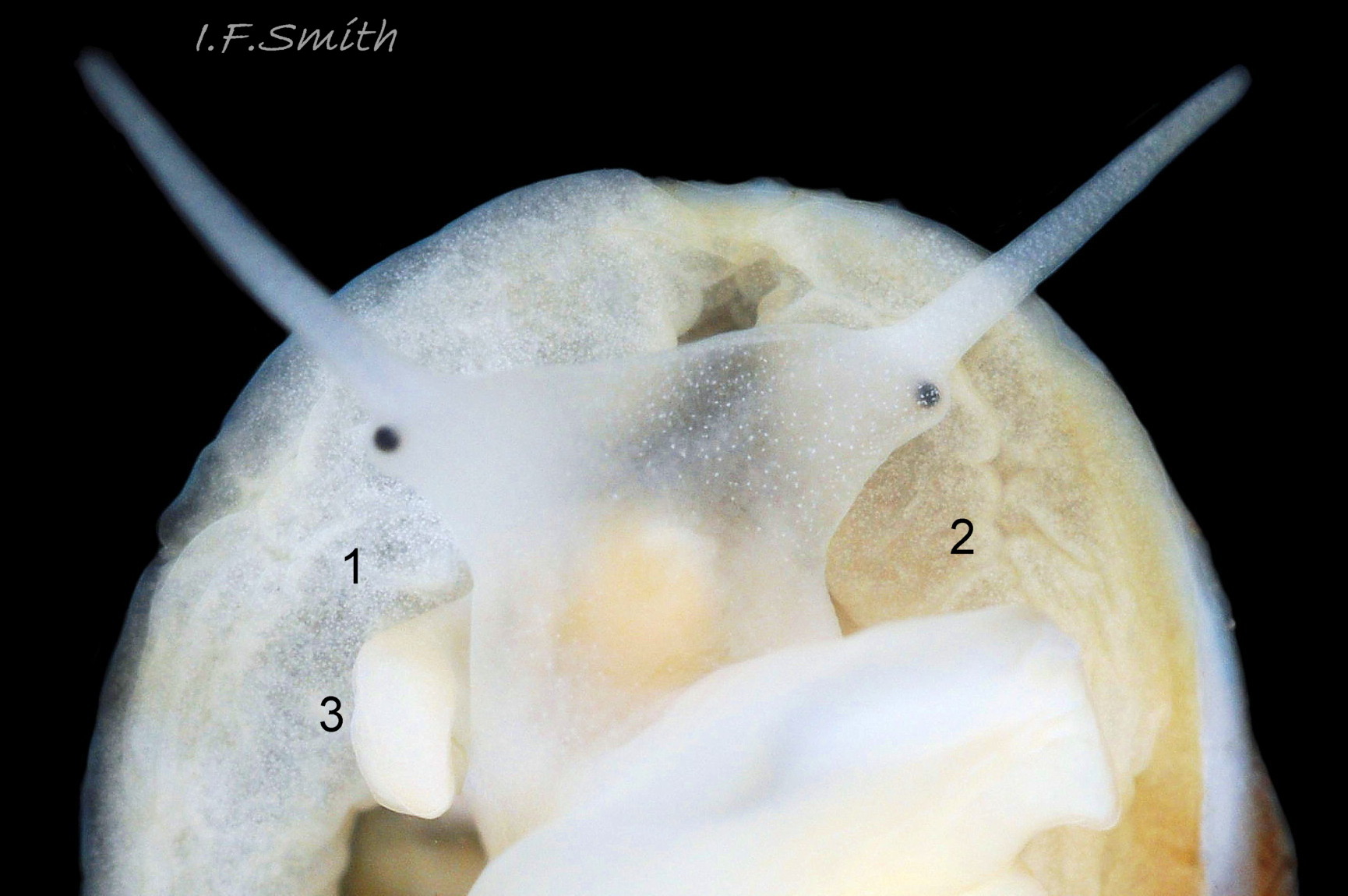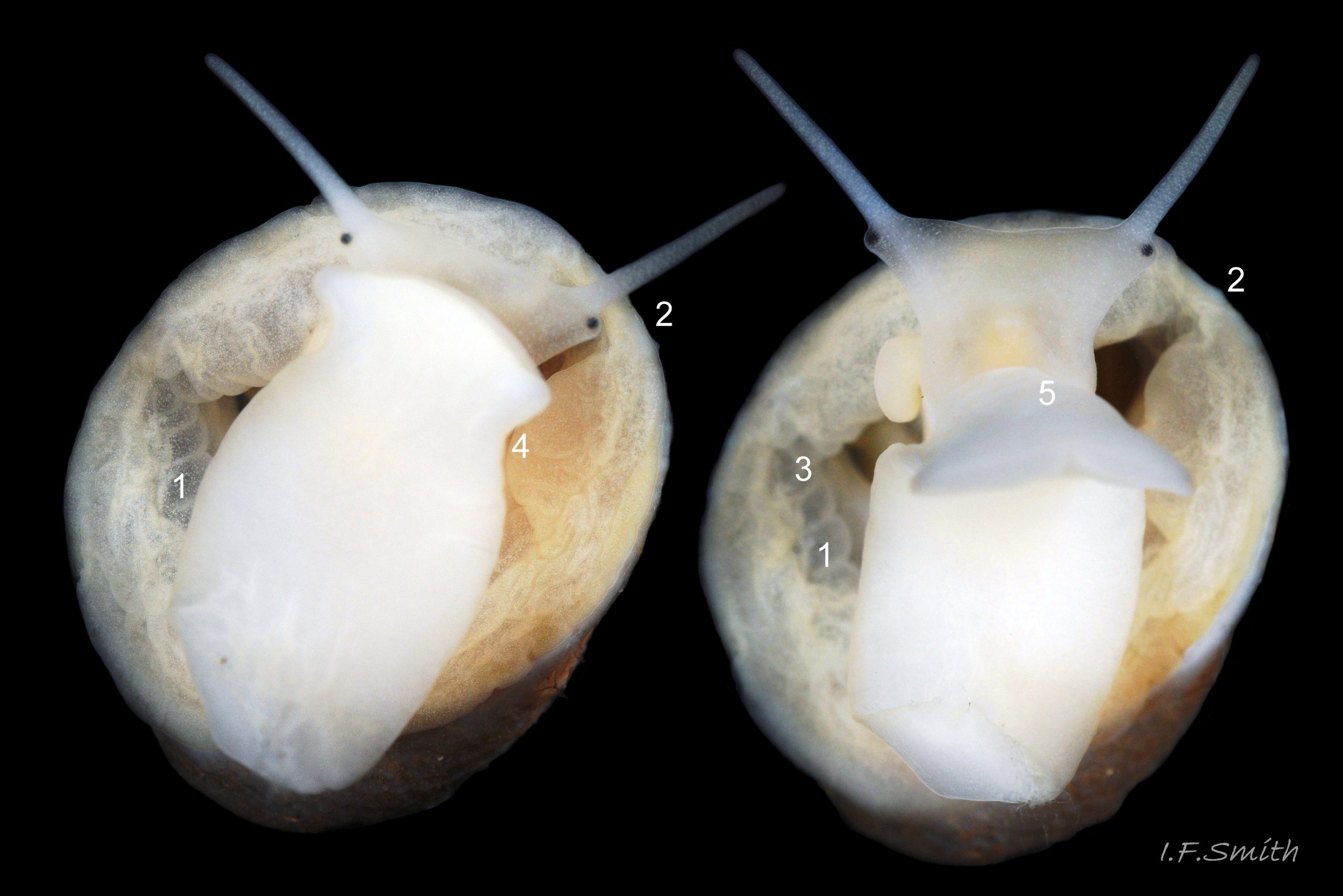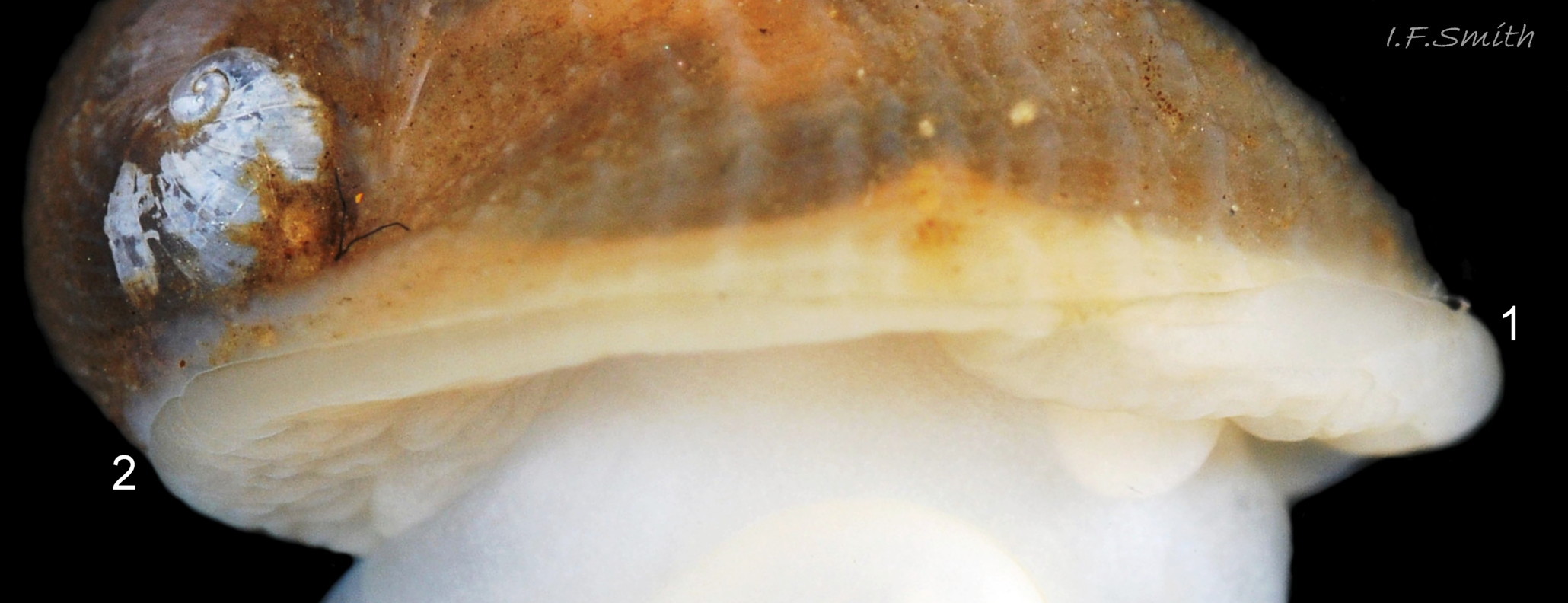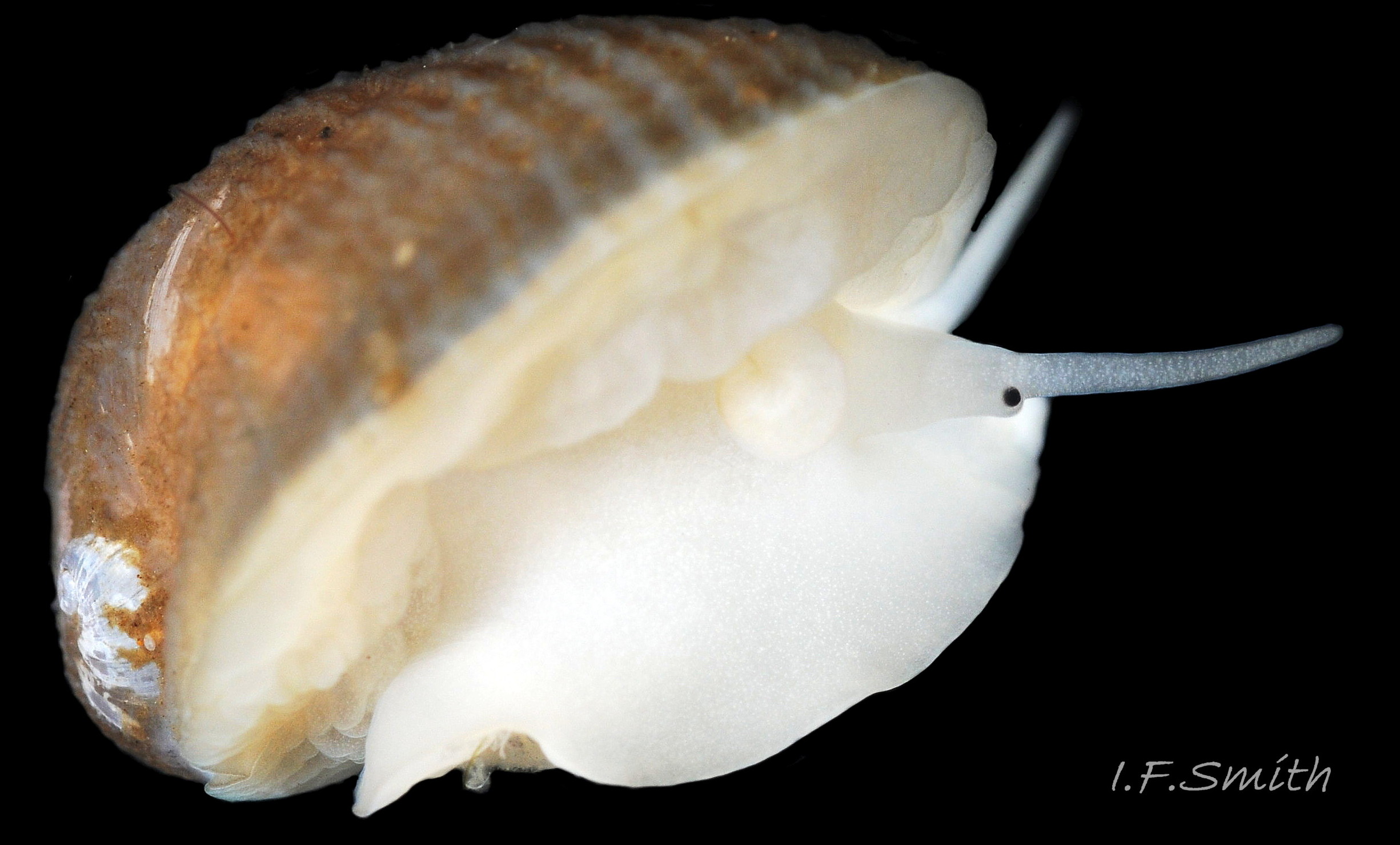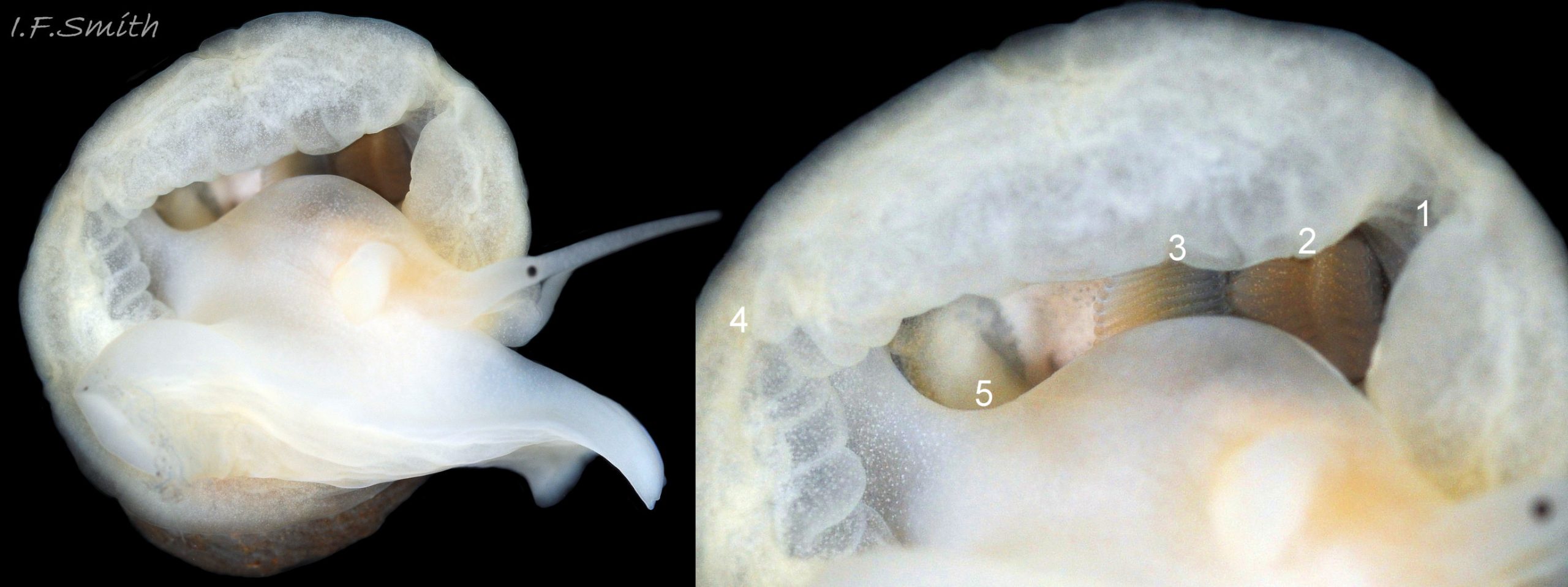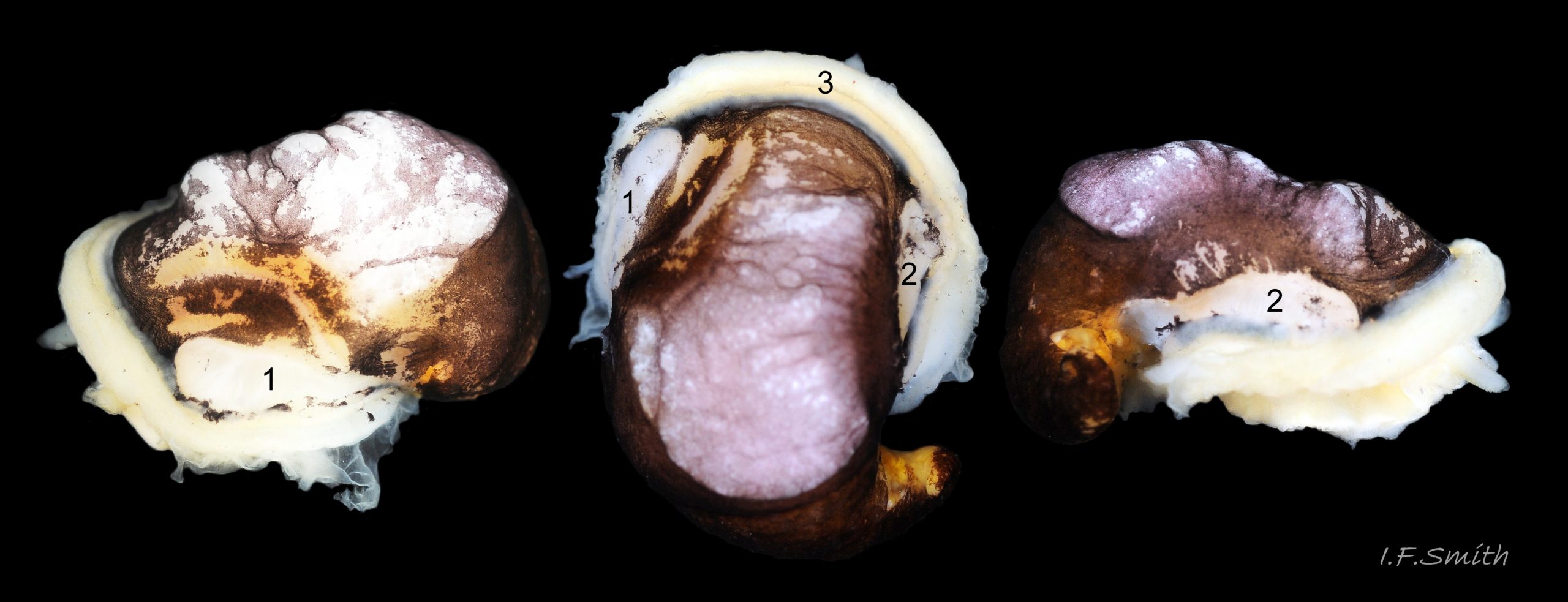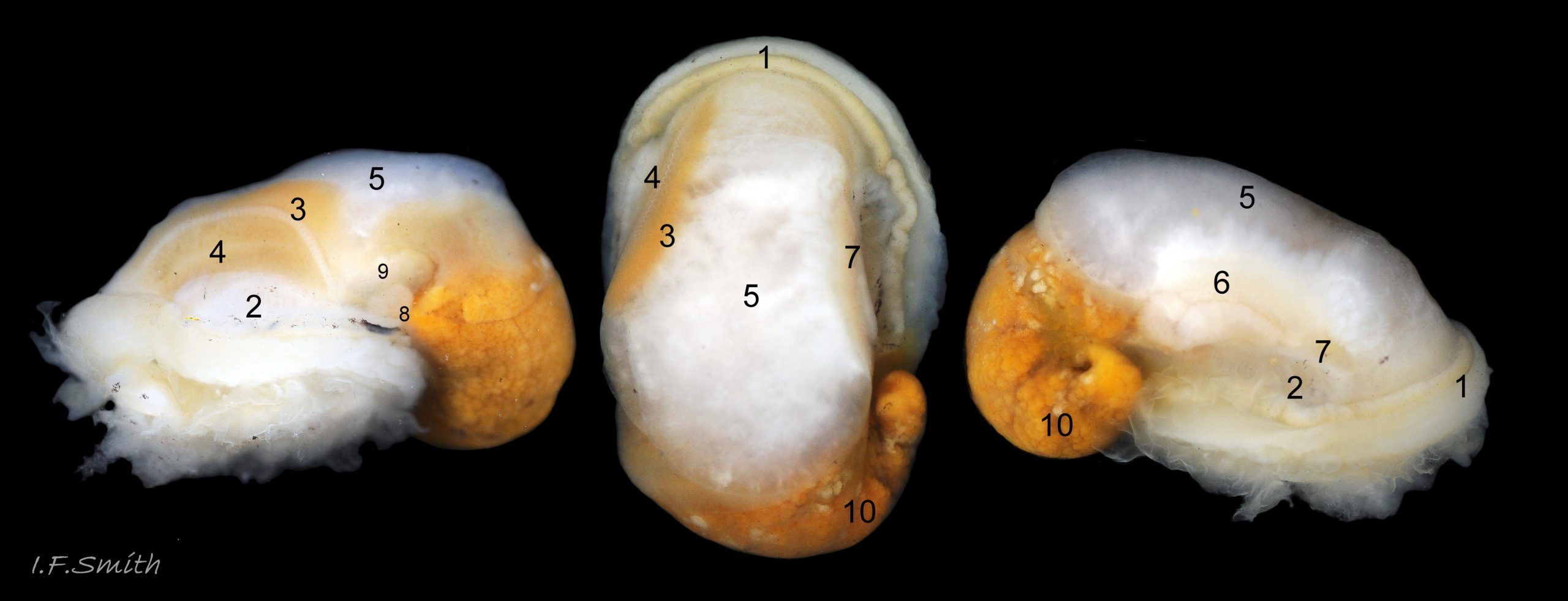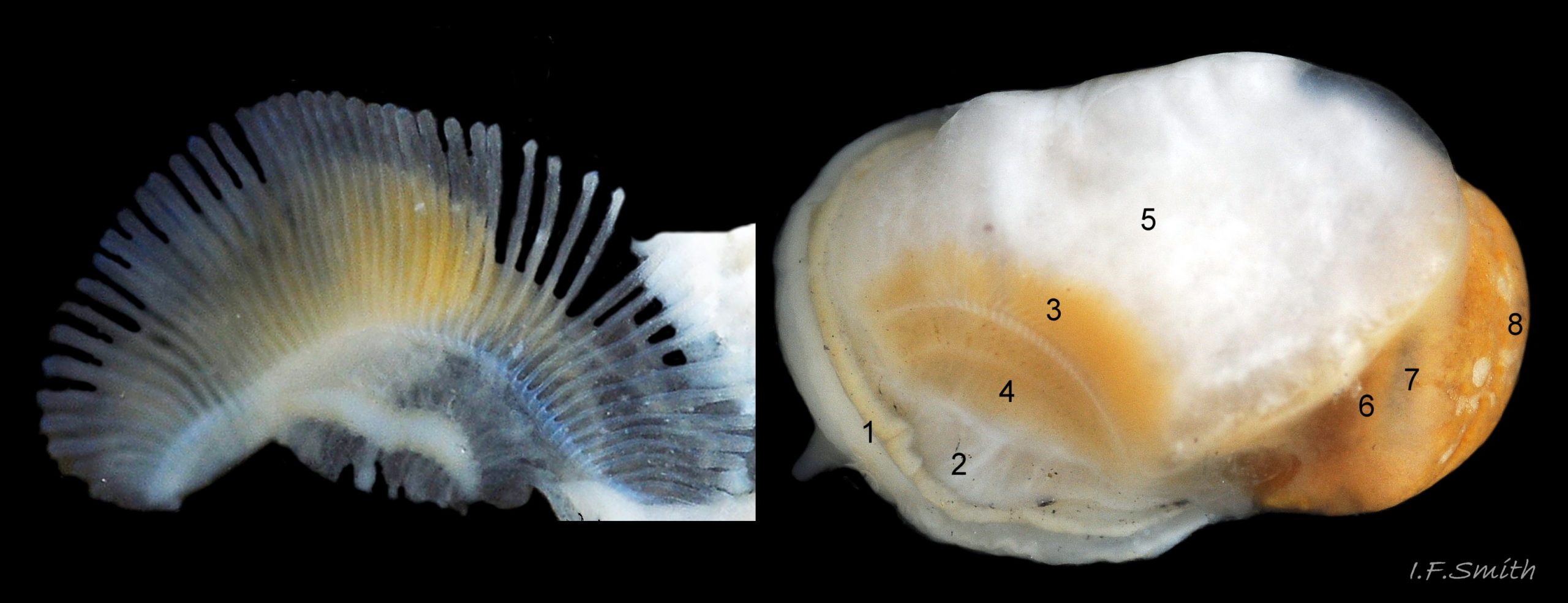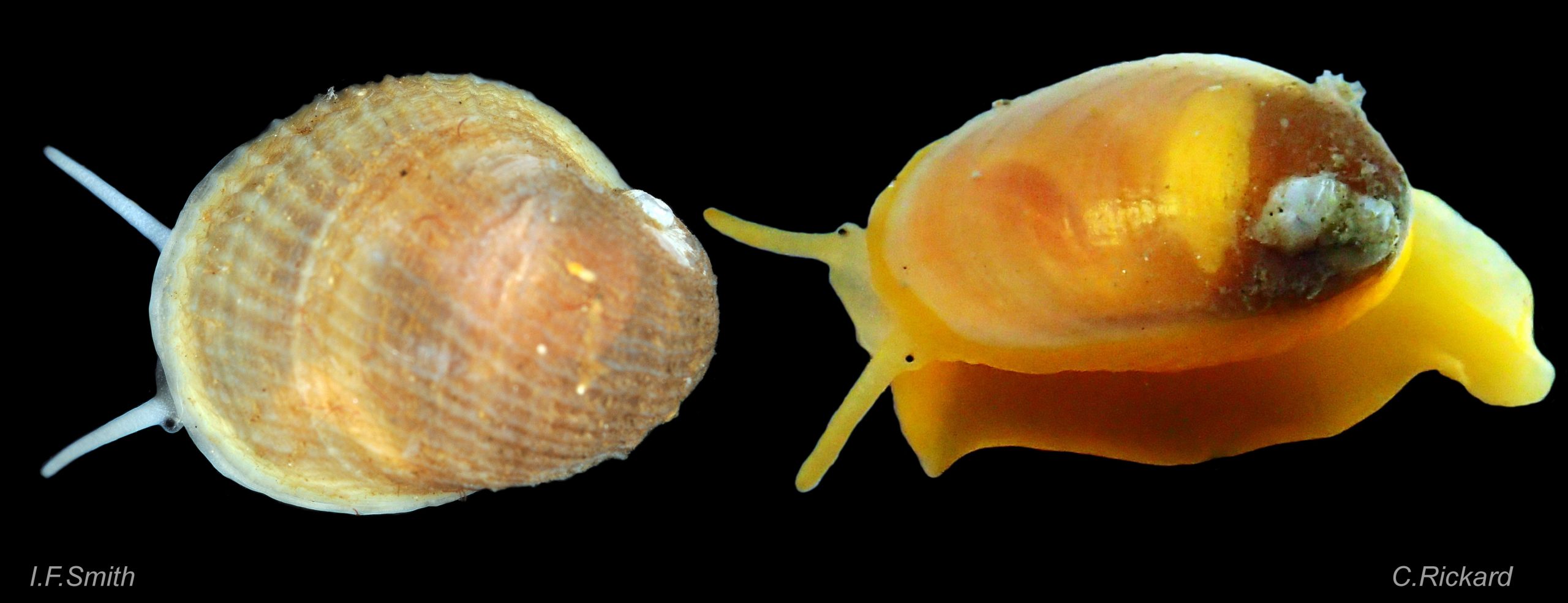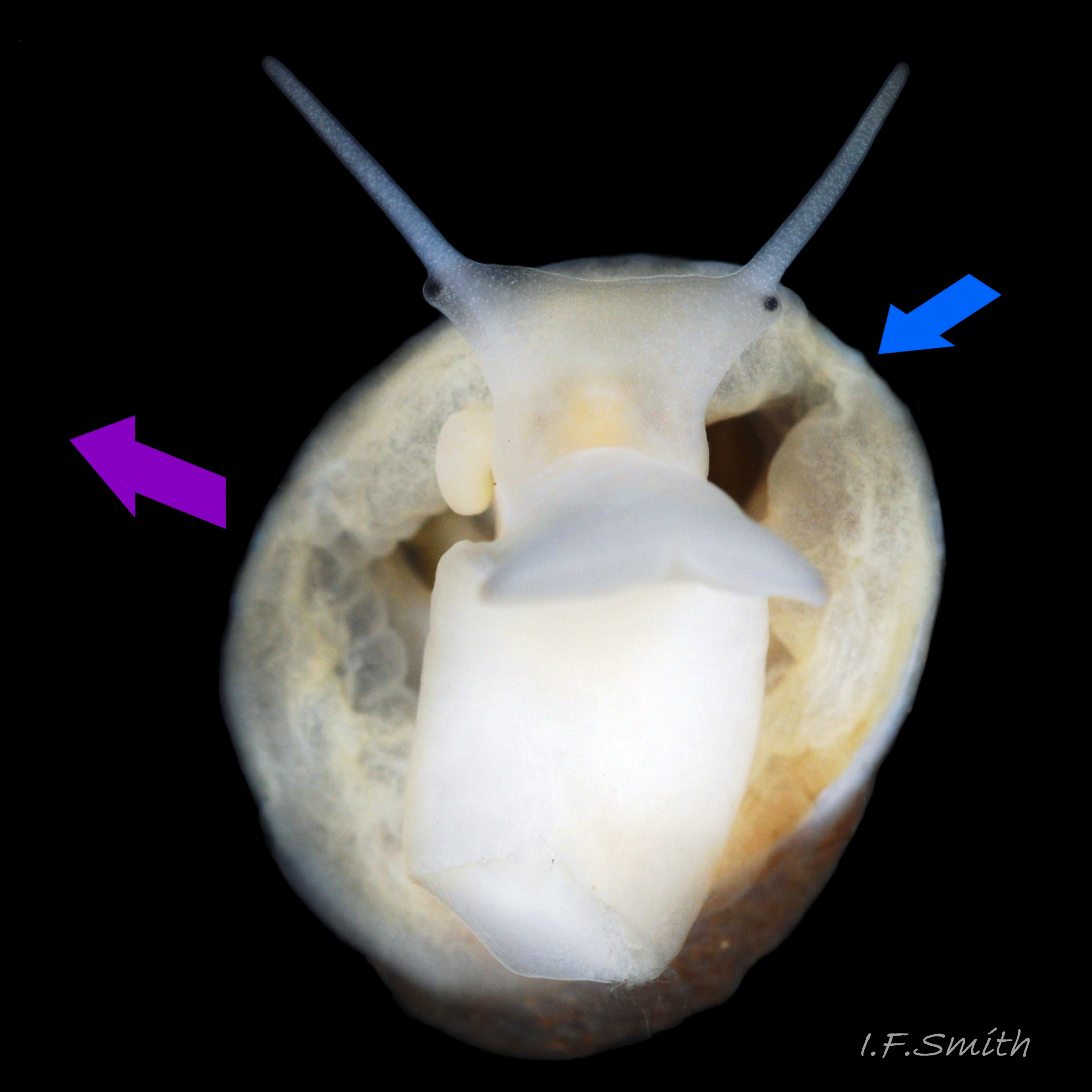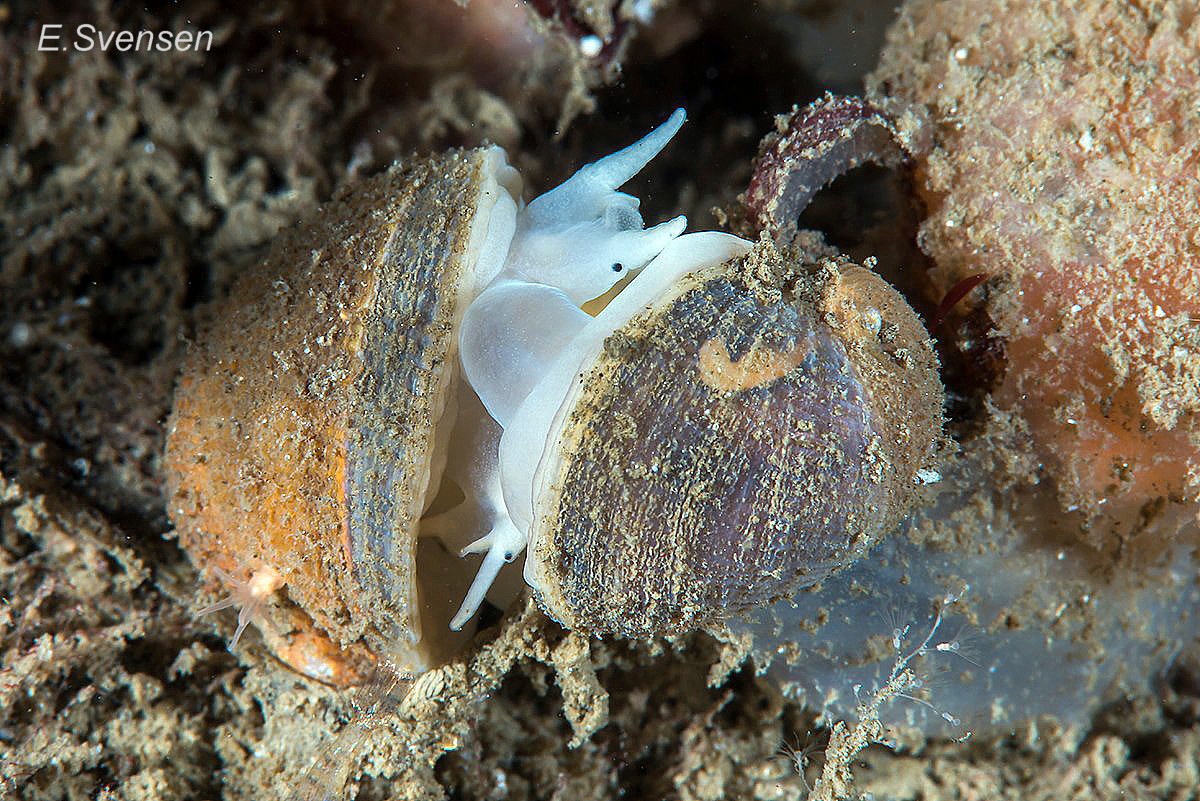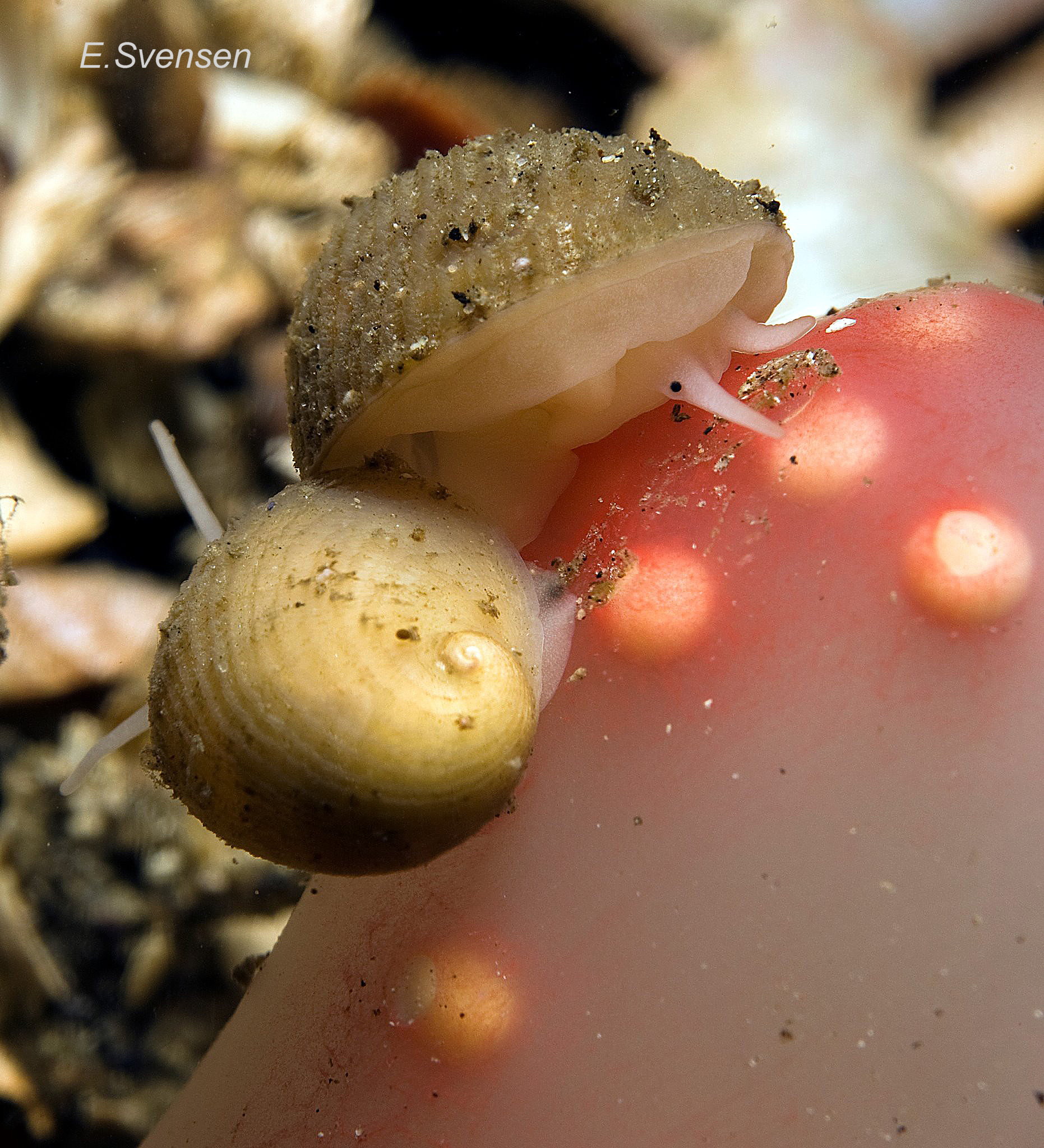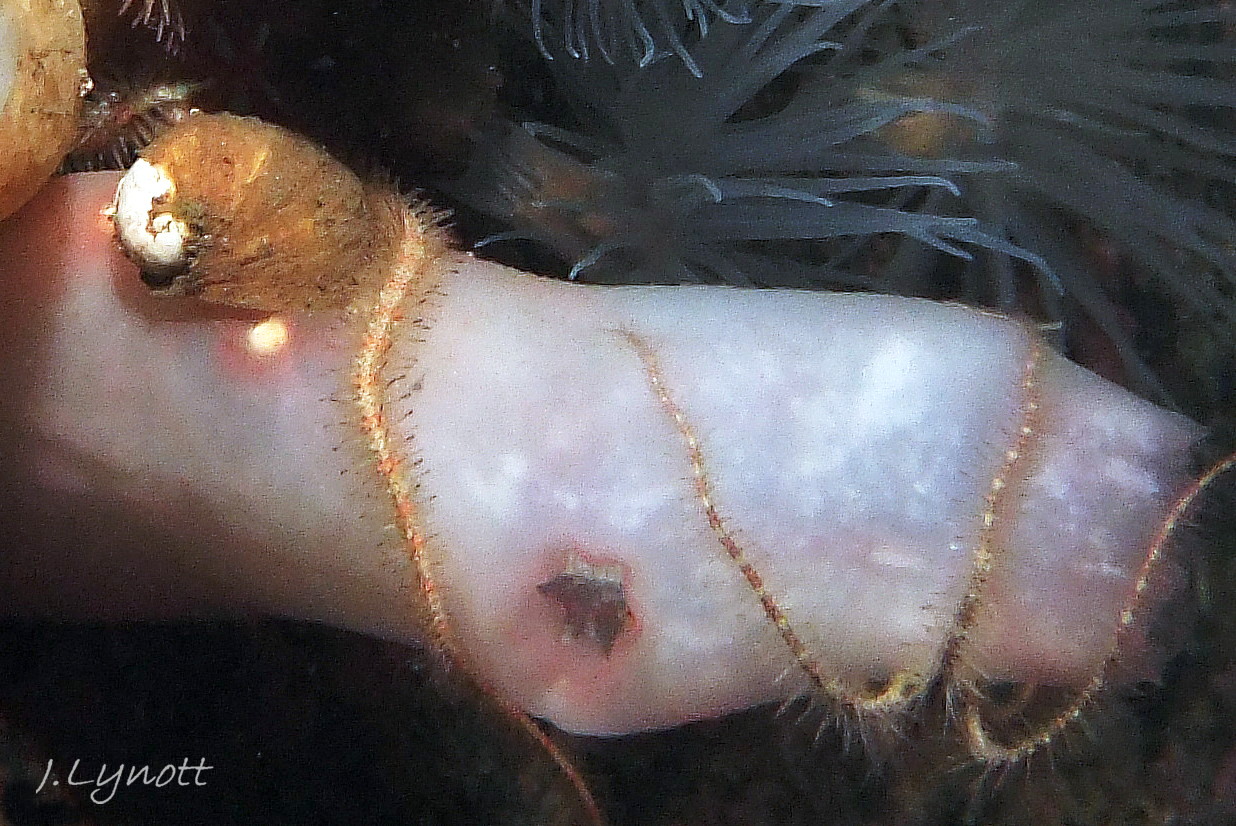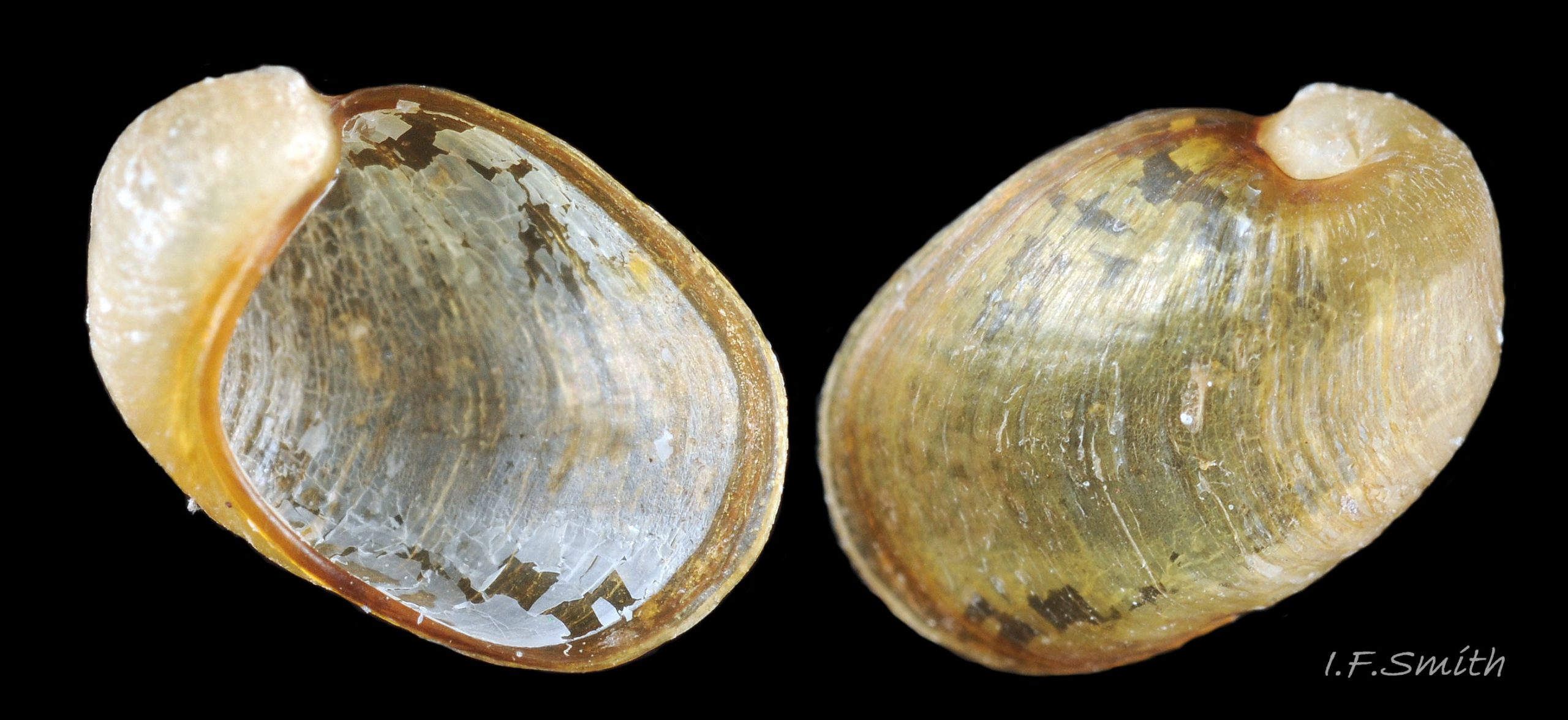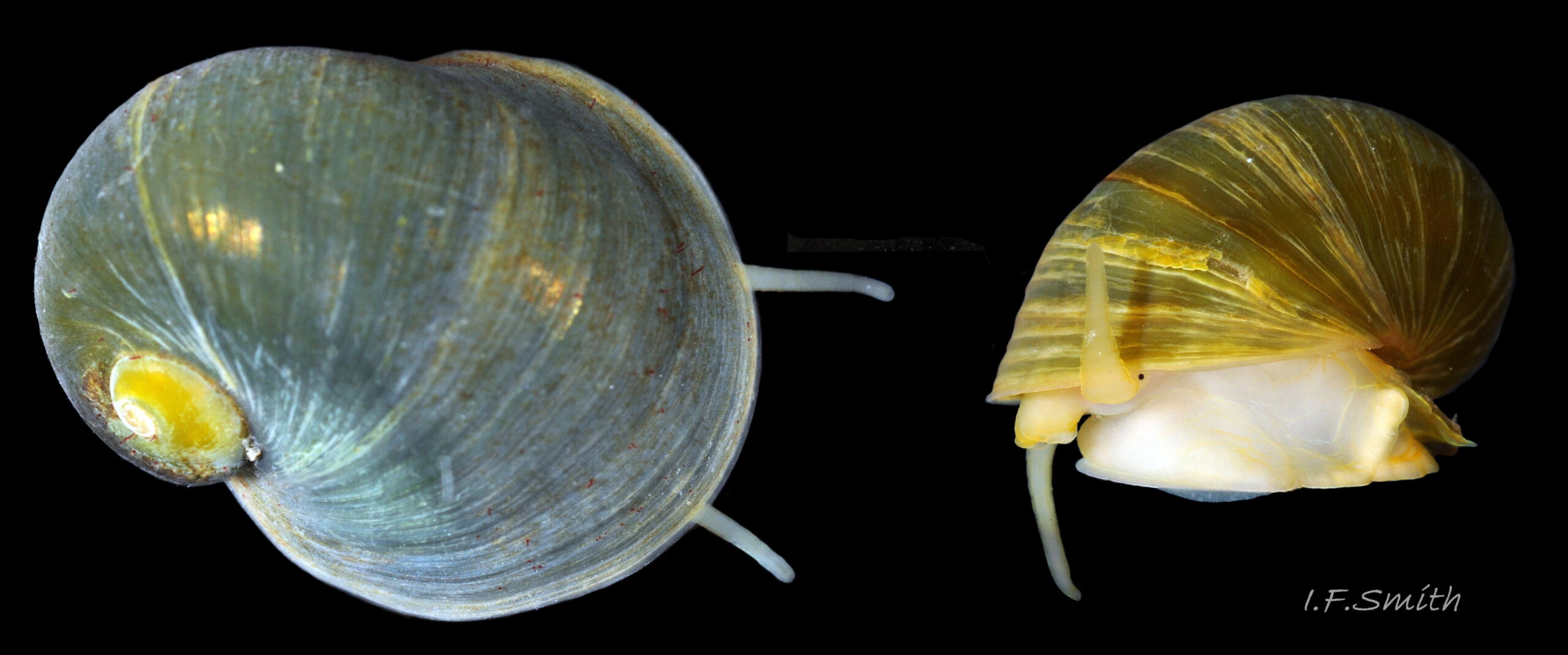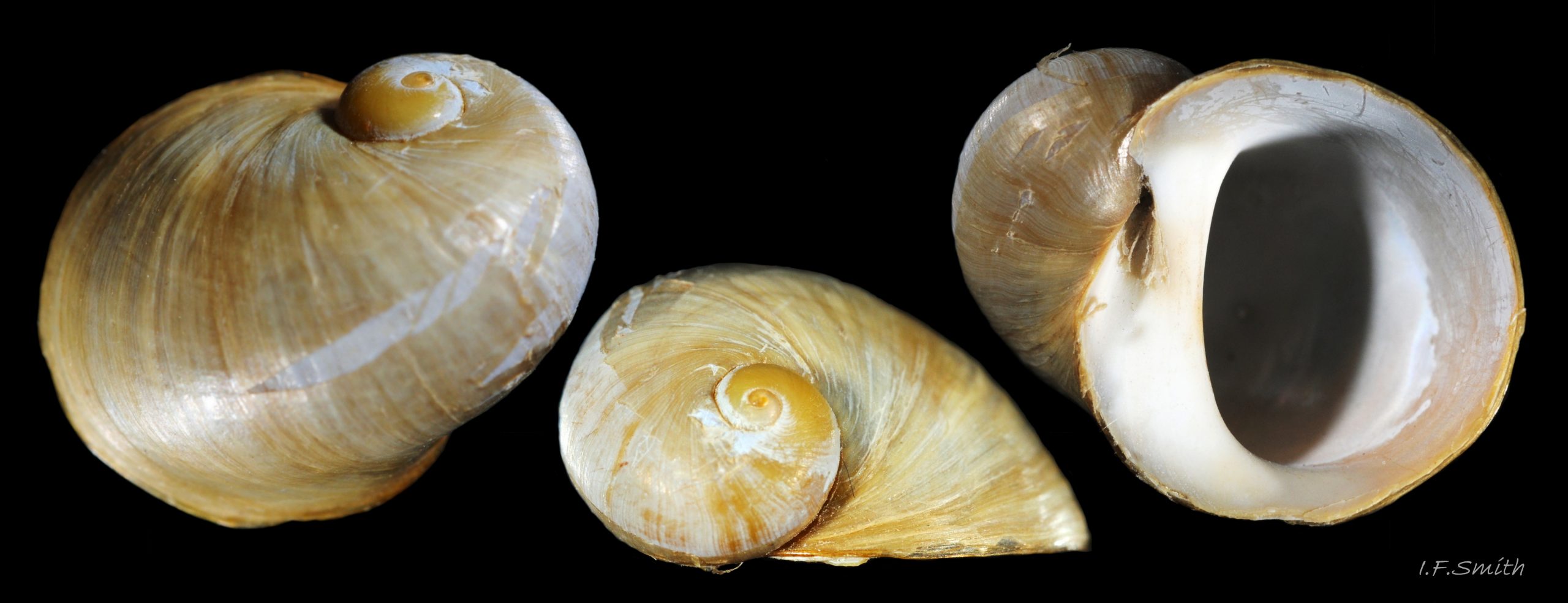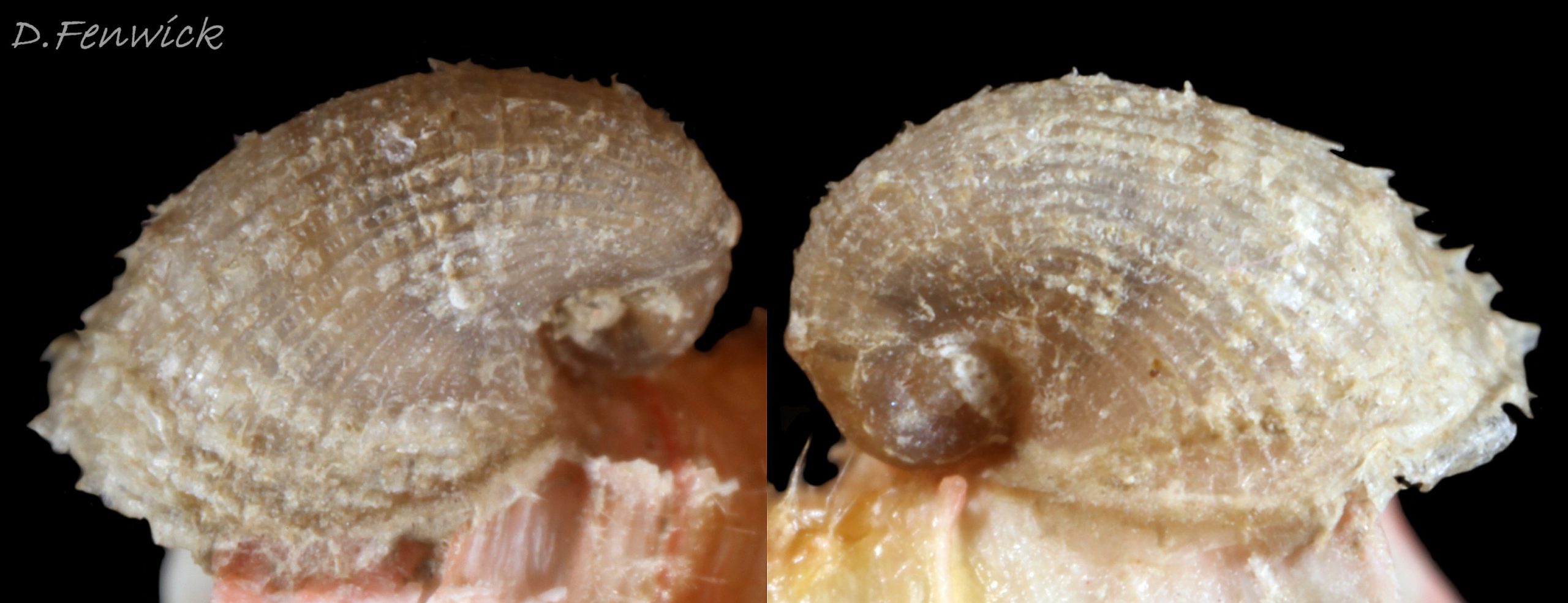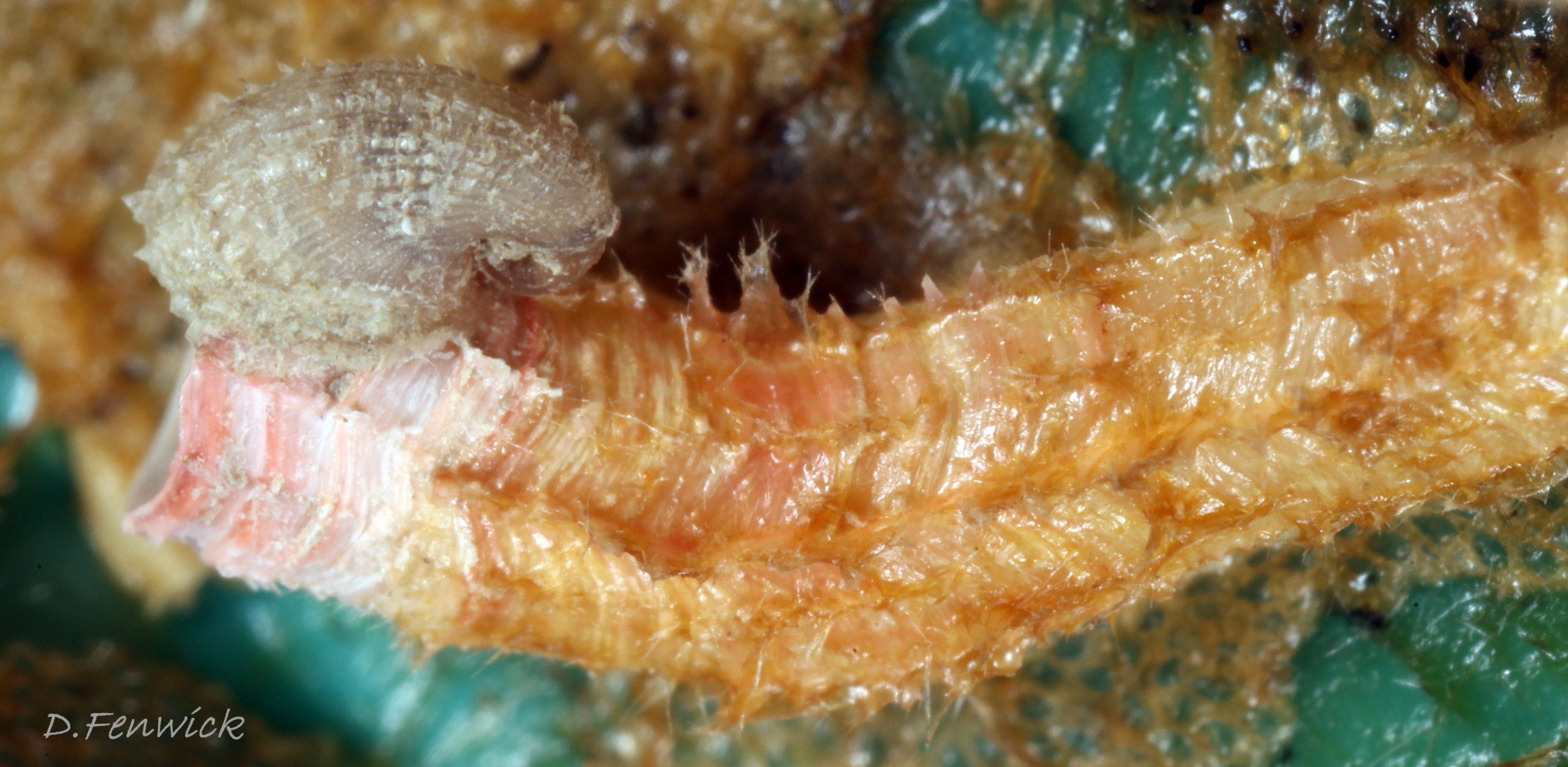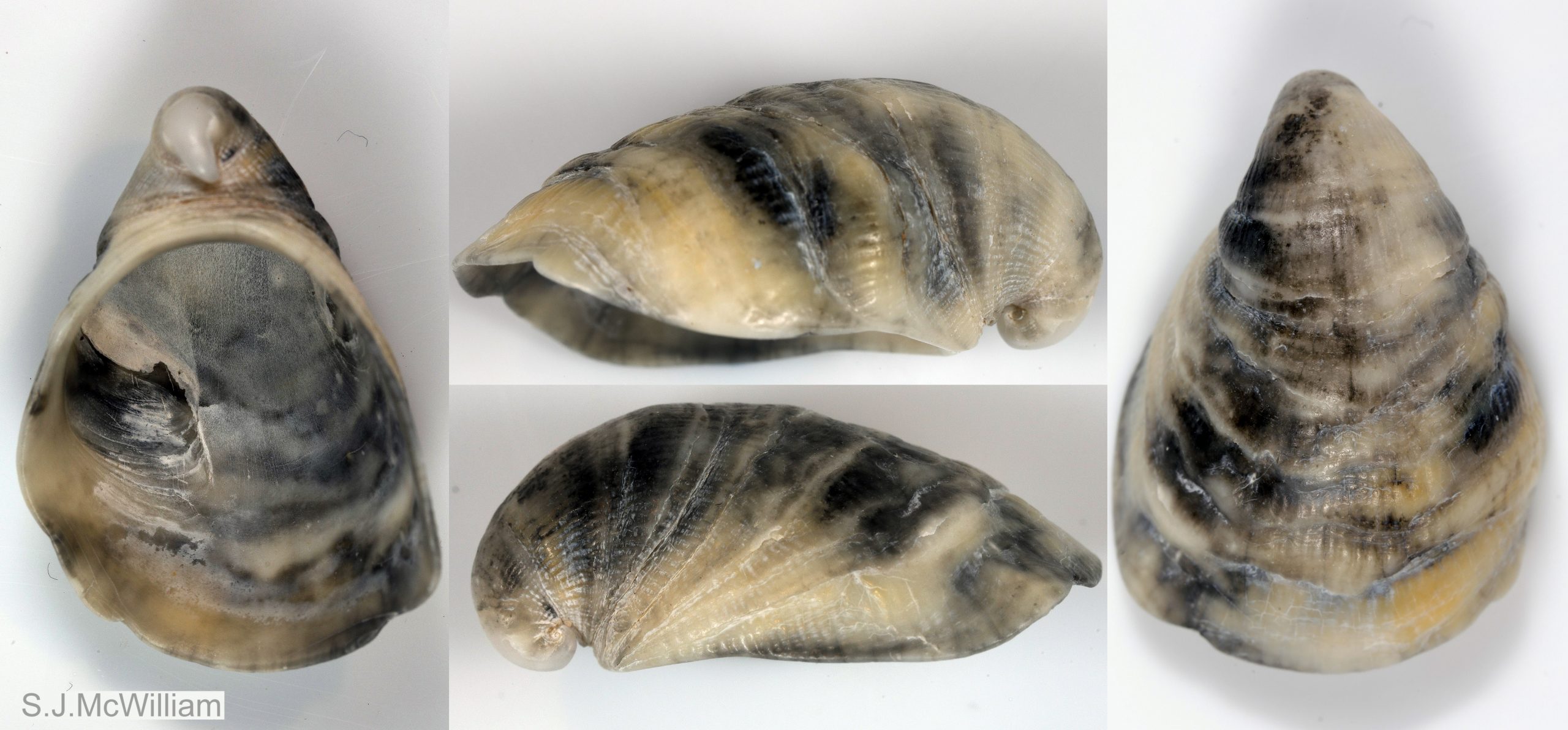Click image to enlarge with full caption. Main text below slider.
Velutina velutina (O. F. Müller, 1776)
Meaning of scientific name:
Velutina (Latin) = velvety (referring to the texture of the live, periostracum-coated shell surface).
Synonyms: Bulla velutina Müller O.F., 1776; Velutina laevigata (O. F. Müller, 1777); Velutina laevigata var. alba Jeffreys, 1867;
Vernacular: Velvet snail (English); Cragen felfed (Welsh); Gewone fluweelhoren (Dutch); Fløjlsskæl (Danish); Sjöpungsnäcka (Swedish): Glatte Samtschnecke (German); Veloutée lisse (French);
GLOSSARY below.
Shell description
Shell height commonly 10mm 01 Velutina velutina, but up to 18mm high and 14mm wide ( McMillan, 1968) and extreme height 22mm (D.W. McKay, in litt. 2019). Specimens from Greenland larger and thicker than in Britain (Jeffreys, 1867). Perpendicular distance from summit of living shell to substrate is c. 50% of shell height. (See 01 Velutina velutina for definition of dimension terms used.) Shell-walls thin. 2.5 rapidly-expanding tumid whorls; body whorl constitutes great majority of shell. Sutures deep, obscured by periostracum when live. Apical angle wide; apex often recessed into a depression 02 Velutina velutina , almost involute.
The slightly glossy, translucent, white or pinkish-white calcareous shell has a sculpture of many very fine growth lines crossed by many very fine, low spiral ridges, forming a faint reticulated pattern 02 Velutina velutina. On live shells, these lines are concealed beneath the substantial light brown periostracum which is raised into many slightly waved, spiral ridges 03 Velutina velutina. Occasionally, the periostracum is white (Telnes, 2019). The brown periostracum reduces translucency of live specimens so the viscera are only faintly discernible 03 Velutina velutina& 04 Velutina velutina . The white, apical protoconch lacks a periostracum. Within 24 hours of drying, the periostracum loses the spiral ridges and shreds into bristle-like fragments 05 Velutina velutina , and it readily flakes off. Consequently, strandline shells 02 Velutina velutina usually have little or no periostracum and are white or pinkish white.
Aperture 01 Velutina velutina almost circular, about 90% of shell-height, about three times as large as visible whorls in apertural view. The palatal and columellar lips run into each other in a smooth curve; the parietal lip is very short but broader than the columellar lip. Adapical angle of aperture rounded. Umbilicus absent. On large older specimens the apex may protrude slightly, and the whorls are more loosely coiled whorls; sometimes with the body whorl separating slightly from the columellar lip to give the false impression of an umbilical slit.
External colour of live shell is brown when periostracum present, translucent white or pinkish white when periostracum lost 05 Velutina velutina.; pink being more frequent and intense in the south of its range. Internally, shell is white or pinkish white, but appears brown when external periostracum shows through it 01 Velutina velutina. The large round aperture resembles that of limpets and, like them, V. velutina has no operculum to seal it.
Body description
The body is white 06 Velutina velutina , sometimes with a faint yellowish or pinkish hue (Jeffreys, 1867), varying in translucency in its different parts, with a very fine opaque white stipple most noticeable where translucency is strongest 07 Velutina velutina. The mantle varies from white or cream to yellowish white with fine, opaque, white stipple 07 Velutina velutina. (“frosted with white points” Fretter & Graham, 1978). The mantle edge is thickened by large, inflated, puckered, connective tissue cells 08 Velutina velutina. blocking the entrance to the mantle cavity, except for the inhalent and exhalent passages. The connective tissue may protrude beyond, but not reflect onto, the palatal lip (anterior of aperture of live specimen) 09 Velutina velutina. Usually, the mantle is reflected slightly onto only the columellar and parietal lips (posterior of aperture of live specimen). The flat head and its smooth, tapering cephalic tentacles are coloured as the body. The anterior of the head is widely truncated as it has no exterior snout, but the short yellow, inverted proboscis is sometimes visible within the semi-transparent head 10 Velutina velutina There is an eye on a basal swelling at the distal side of each cephalic tentacle. A white or yellowish penis 06 Velutina velutina, and 07 Velutina velutina is located behind the right tentacle of all adults as, unusually for a prosobranch, the species is hermaphrodite.
The dorsal surface of the foot is coloured as the body, but the opaque stipple may be difficult to discern as the foot has weak translucency 11 Velutina velutina. When in motion on a flat surface, the unstippled white sole is ovate with a constriction close to the broadly curved anterior shaped like an axehead with flexible corners 08 Velutina velutina. The foot readily folds transversely at the constriction. Through the inhalent and exhalent passages in the pallial connective tissue it is sometimes possible to partially see , within the mantle cavity 12 Velutina velutina : the ctenidium; the smaller, but similarly comb-shaped osphradium (misinterpreted as a second ctenidium in early works [Forbes & Hanley, 1853 and Jeffreys,1867]); the hypobranchial gland; and rectum. If the relaxed and killed animal is removed from the shell and the black pigment 13 Velutina velutina rubbed off the translucent mantle, it should be possible to see 14 Velutina velutina& 15 Velutina velutina the ctenidium and osphradium, the right columellar muscle; the smaller left columellar muscle; the very extensive white hypobranchial gland lining the entire roof of the mantle cavity to the right of the ctenidium; the genital ducts; the rectum; the auricle and ventricle of the heart; and the ovotestes.
Key identification features
Velutina velutina
1 When live, white, or pinkish white, calcareous shell is covered, except apical protoconch, by substantial brown periostracum that is raised into spiral ribs 01 Velutina velutina. Periostracum distorts when dry 05 Velutina velutina.
2 When live, shell is weakly translucent and only indistinctly shows the viscera 04 Velutina velutina & 16 Velutina velutina.
3 Aperture large and almost circular; about three times as large as visible whorls in apertural view 01 Velutina velutina.
4 Columellar lip has no umbilicus or groove 01 Velutina velutina.(Gap between body whorl and aperture sometimes occurs on large old specimens and might be mistaken for umbilical groove)..
5 Spire does not usually protrude beyond body whorl; apex often recessed into a depression 02 Velutina velutina. Apex on large old shells may protrude slightly
6 When live and active, mantle may extend beyond the aperture rim, but only reflected onto the shell at the rear of the aperture ( columellar/parietal lips) 09 Velutina velutina.
7 Flesh translucent white with fine, opaque white stipple 06 Velutina velutina
Similar species
Velutina plicatilis (O. F. Müller, 1776)
1 Shell is horn coloured, made principally of thick, slightly hispid periostracum; not raised into spiral ribs. Flimsy, thin, white, interior calcareous layer readily flakes off when dry, leaving just the periostracum 20 Velutina velutina
2 When live, shell is translucent often showing form and colour of viscera within; mainly yellow and orange 16 Velutina velutina
3 Large, elongate oval aperture; about three times as large as visible whorls in apertural view 20 Velutina velutina.
4 Columellar lip has no umbilicus or groove 20 Velutina velutina album.
5 Spire does not protrude beyond body whorl; usually recessed into a depression 20 Velutina velutina.
6 When live and active, mantle is obviously reflected a short way onto the shell all around the aperture 16 Velutina velutina .
7 Flesh and mantle bright yellow or orange 16 Velutina velutina.
Lacuna pallidula (da Costa, 1778)
1 When live, calcareous, white shell is covered by substantial periostracum that is smooth, apart from numerous growth lines; brown or olive-brown on adults, brownish white or yellow on younger ones 21 Velutina velutina. Periostracum readily flakes off when dry 22 Velutina velutina.
2 When live, adult shell is opaque 21 Velutina velutina.but juveniles under 3mm often translucent showing flesh and viscera.
3 Large, D shaped aperture about same size as visible whorls in apertural view 22 Velutina velutina.
4 Columellar lip has large groove (chink) and umbilicus 22 Velutina velutina.
5 Low spire protrudes, not recessed into a depression 22 Velutina velutina .
6 When live and active, mantle may protrude very slightly, but is not reflected onto the shell 21 Velutina velutina.
7 Flesh usually white, often with some yellow on snout, penis and parts of foot. Sometimes flesh is pink or whitish grey 21 Velutina velutina .
Capulus ungaricus
1 When live, white, calcareous shell is covered, including apical protoconch, by substantial pale, straw-coloured periostracum that is raised into spiral ribs 23 Velutina velutina. Periostracum extends beyond aperture as fragments that form a fringe on adults.
2 When live, shell is weakly translucent.
3 Aperture large and almost circular with only the small curled spire visible in apertural view 25 Velutina velutina.
4 Columellar lip has no umbilicus or groove.
5 Small, downward coiled spire protrudes almost centrally from beyond body whorl. Apex not recessed into a depression, and turned only slightly to the right of the animal 23 Velutina velutina & 25 Velutina velutina.
7 Flesh yellowish with white speckles . Proboscis permanently extended (Graham, 1988).
8 Juveniles often found near open end of Pomatoceros tubes 24 Velutina velutina; adults near bivalves and Turritella, purloining food particles brought in by the hosts’ inhalent currents, or their pseudofaeces.
Habits and ecology
V. velutina lives mainly sublittorally to depths of 1000 metres Hayward & Ryland (1995) on hard substrate, especially shelly ground (Forbes & Hanley, 1853), where its unitary ascidian prey, Ascidia, Phallusia and Styela coriacea occur (Fretter & Graham, 1962). Rarely, live specimens are found at ELWS in northern Scotland.
Respiration is with inhalent water brought into the mantle cavity via a passage through the connective tissue by the left of the head 17 Velutina velutina. In the cavity, it first passes through the reddish osphradium 12 Velutina velutina which tests the water quality and probably removes large particles of detritus. It then passes through the dull yellow ctenidium which acquires oxygen from the water for the haemolymph (‘blood’) passing through it and releases carbon dioxide which passes with the water out of the animal via an exhalent passage through the connective tissue on the right side of the body. Locomotion is on the large foot lacking a medial dividing groove on the sole. When live, the foot usually remains in contact, limpet-like, with the substrate. V. velutinafeeds by biting open the tough test of unitary ascidians to access the soft inner parts. The rectum and anus 12 Velutina velutinaare near the exhalent passage where faeces exit the animal with the exhalent water. Clark in Jeffreys (1867) reported that it “discharges a very copious and tenacious clear white slime” which may have protective qualities. It may breed all year as veliger larvae have been seen in summer and autumn off Plymouth, S. England (Fretter and Graham, 1962) and mating at 3ºC and ova have been photoraphed in Norway in December and January . If breeding is triggered by temperature it is likely that it takes place at different dates at different levels of its great depth range in different geographical areas. Fretter and Graham (1962) considered it to be a simultaneous hermaphrodite. A photo of mating 18 Velutina velutina shows a couple lying head-on, foot to foot, on their left sides so their right-side genitalia are adjacent. In the photo, the massively engorged penis of only one of them can be seen to be penetrating the other. For oviposition, the radula cuts round holes a few mm from each other in the ascidian. The foot positions large, spherical pot-shaped egg capsules in the holes 19 Velutina velutina & 19.1 Velutina velutina . Only the transparent plug in the opening of the capsules is visible on the surface of the ascidian. Each capsule contains hundreds of unshelled ova in an albuminous fluid. The plug is freed from the opening for the planktonic bilobed veliger larvae to escape.
Distribution and status
Circumpolar distribution from high Arctic southwards to Galicia, Spain; Cape Cod, Atlantic USA; San Diego, Pacific USA; and Japan. Very few records from continental coast of southern North Sea. GBIF map www.gbif.org/species/2299230 . All around Britain and Ireland where suitable hard substrate and ascidians. Most records are live sublittoral or dead strandline, but some live littoral records from N. Scotland. Few records of any sort from NE Irish Sea, mid Wales, SW England and between Kent and Humber; U.K. interactive map NBN species.nbnatlas.org/species/NHMSYS0021055637
Acknowledgements
This account would not have been possible without the shore work of David McKay and Simon Taylor and their kindness in supplying me with a live specimen to photograph; I thank them both. Sincere thanks are also due to Erling Svensen for the use of his excellent images of mating and ova; and, for comparison purposes, to Chris Rickard for photos and specimens of V. plicatilis and to David Fenwick and Steve McWilliam for images of Capulus ungaricus.
Links and references
Forbes, E. & Hanley S. 1849-53. A history of the British mollusca and their shells. vol. 3 (1853), London, van Voorst. (As Velutina laevigata archive.org/stream/historyofbritish03forbe#page/346/mode/2up p346)
Fretter, V. and Graham, A. 1962. British prosobranch molluscs: their functional anatomy and ecology. , London, Ray Society.
Fretter, V. and Graham, A. 1978. The prosobranch molluscs of Britain and Denmark. Part 6 – Cerithiacea, Strombacea, Hipponicacea, Calyptraeacea, Lamellariacea, Cypraeacea, Naticacea, Tonnacea, Heteropoda. J. Moll. Stud. Suppl. 9.
Graham, A. 1988. Prosobranch and pyramidellid gastropods. Linnean Synopsis No.2 (Second Edition). Leiden, Brill & Backhuys,.
Hayward, P.J. & Ryland, J.S. (eds.) 1995 and reprints to 2009. Handbook of the marine fauna of North-West Europe. , Oxford, Oxford University Press.
Jeffreys, J.G. 1862-69. British conchology. vol. 4 (1867). London, van Voorst. (As Velutina laevigata; Free pdf at archive.org/details/britishconcholog04jeffr/page/240 . Use slide at base of page to select pp 240 to 244.
McMillan, N.F. 1968. British shells. London, F. Warn.
Müller, O.F. 1776. Zoologiae Danicae prodromus : seu Animalium Daniae et Norvegiae indigenarum ; characteres, nomina, et synonyma imprimis popularium Original description, as Bulla velutina, item 2922 on p. 242.
www.biodiversitylibrary.org/item/47550#page/278/mode/1up
Telnes, K. accessed June 2019. The marine flora and fauna of Norway
www.seawater.no/fauna/mollusca/velutina.html [Subaquatic images of live specimens, including one with a white periostracum.]
Current taxonomy: World Register of Marine Species (WoRMS) www.marinespecies.org/aphia.php?p=taxdetails&id=141905
Glossary
abapical = away from the apex of the shell.
adapical = towards the apex of the shell.
aperture = mouth of gastropod shell; outlet for head and foot.
cephalic = (adj.) of or on the head.
columella = solid or hollow axial “little column” around which gastropod shell spirals; hidden inside shell, except on final whorl next to lower part of inner lip of aperture where hollow ones may end in an umbilicus or siphonal canal.
columellar = (adj.) of or near central axis of spiral gastropod.
columellar lip = lower (abapical) part of inner lip of aperture.
ctenidium = comb-like molluscan gill; usually an axis with a row of filaments either side.
distal = away from centre of body or from point of attachment.
ELWS = extreme low water spring tide (usually near March and September equinoxes).
height = (of gastropod shells) distance from apex of spire to base of aperture.
hispid = surface roughened by minute, stiff bristles.
hypobranchial gland = thickened, sometimes puckered, tissue on roof of mantle cavity of many gastropods. Secretes mucus to trap and consolidate particles from inhalent water. Often other biologically active compounds produced.
mantle = (a.k.a. pallium) sheet of tissue that secretes the shell and forms a cavity for the gill in most marine molluscs.
operculum = plate of horny conchiolin, rarely calcareous, used to close shell aperture.
osphradium (pl. osphradia) = organ for testing water quality (chemical and/or for particles) usually near approach of inhalant current to ctenidium. Structure varied; including comb-like, papillate or ribbing.
ovotestis = hermaphrodite organ serving as both ovary and testis.
palatal lip = outer lip of gastropod aperture.
pallium = (see mantle).
pallial = (adj.) of the pallium/mantle.
parietal lip/wall = upper part of inner side of gastropod aperture, often lacking clear lip structure with just a glaze on side of whorl adapically of columellar lip.
periostracum = thin horny layer of chitinous material often coating shells.
plankton = animals and plants that drift in pelagic zone (main body of water).
proboscis = internal feeding tube, containing the buccal mass with radula, that is only extended, often by inversion like a sock turned inside out, when feeding.
prosobranch = member of Prosobranchia, one of three subclasses into which the class Gastropoda (slugs and snails) was divided during the 20th Century (other two were Pulmonata and Opisthobranchia). This classification is no longer used by scientists, but prosobranch is a useful informal term to signify (mainly marine) snails breathing with a ctenidium (comb-like gill inside mantle cavity), an operculum, and a shell which can accommodate the whole body. There are some exceptions, based on soft part anatomy, such as the prosobranch seaslug Lamellaria with a concealed internal shell and no operculum, and the opisthobranch snail Acteon which can withdraw within its shell. See en.wikipedia.org/wiki/Prosobranchia
reflected = (of mantle edge) folded back over the rim of the shell’s aperture.
umbilicus = cavity up axis of some gastropods, open as a hole or chink on base of shell, often sealed over.
suture = groove or line where whorls of gastropod shell adjoin.
tumid = bulging, distended, distinctly convex.
veliger = shelled larva of marine gastropod or bivalve mollusc which swims by beating cilia of a velum (bilobed flap).

